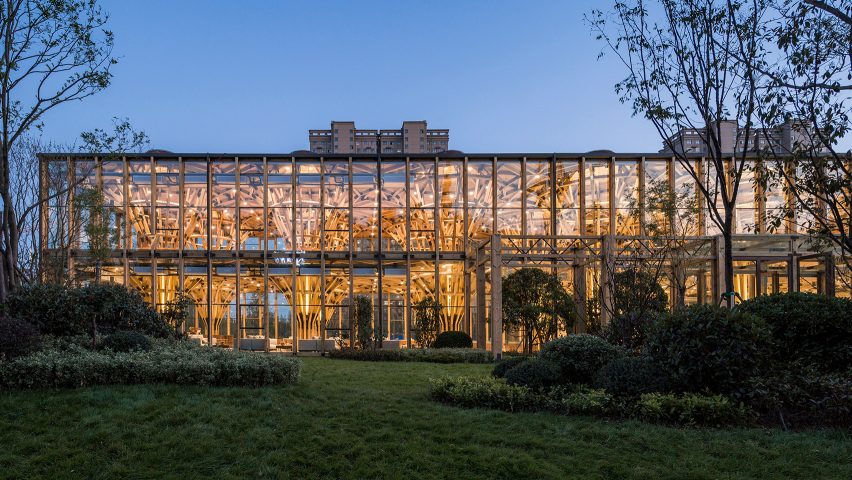This real-estate sales centre in China's Henan province features a wooden structure designed by architecture firm LUO Studio to be easily adapted or dismantled.
Located in Puyang County, the Longfu Life Experience Centre was commissioned by an eco-farm operator engaging in property development, who required a space to target consumers chasing a green lifestyle.
It was vital that it was sustainable and built from natural materials, to match his corporate identity.
Given the short lifespan of typical real-estate sales centres in China, LUO Studio also set out to develop a structure for that could be used in various ways, rather than limited to its primary function.
Using Mies van der Rohe's Crown Hall at the Illinois Institute of Technology in Chicago as a model, the Beijing-based architects devised a modular structure, made up of units that could be produced from just three components.
The modules take the form of "clustered columns", inspired by the shape of trees. These can be applied independently or combined with others "just like Lego bricks"
"The clustered column was divided into five segments" the architects explained. "The bottom part of each clustered column is in the shape of a regular polygon. These extend upward from the bottom and form a square outside edge."
The result is a building that can be easily extended, reduced, or completely dismantled and rebuilt elsewhere.
The small bases of these columns give the building its desired versatility, as they create a largely open-plan interior.
Currently the ground floor is a multifunctional space containing a mix of furniture, suitable for big events or small meetings.
On the first floor is a mezzanine gallery framed by glass balustrades. Here, tables are built into the columns.
LUO Studio hopes the project will challenge the commonplace interiors of these sorts of sales centres, which is described as "wasteful and complicated".
The building also integrates building services into its structure.
By protruding from the roof, the columns double as light wells to reduce dependency on artificial lighting, while the plant and service rooms are all grouped into a single zone on the west side of the building.
LUO Studio is not the first practice to use timber to create an adaptable building structure.
The wooden framework of a Japanese house by Akasaka Shinichiro Atelier allows its owners to adapt the ground floor, while BIG's 79 & Park apartment block is divided into units that create a flexible and inexpensive building.
Photography is by Jin Weiqi.
Project credits:
Design studio: LUO studio
Chief designer: Luo Yujie
Participating designers: Wang Xiaotao, Wei Wenjing
Client (design consultant): Lai Lijun
Construction company: Puyang JINGYI Architectural Decoration, Design and Engineering

